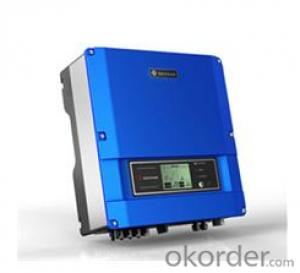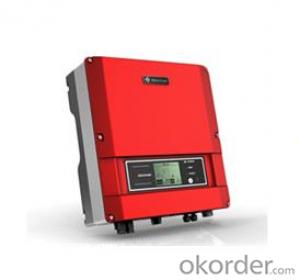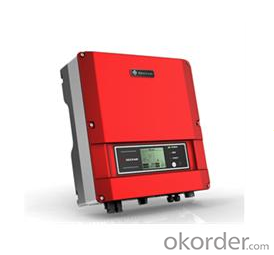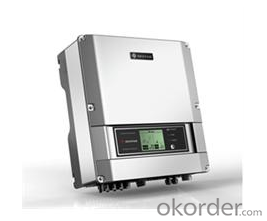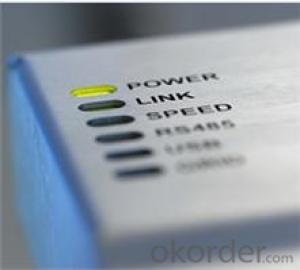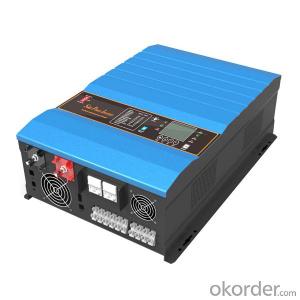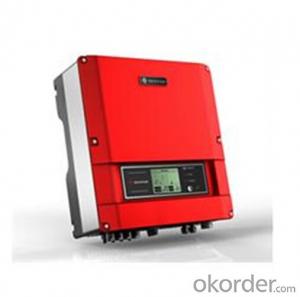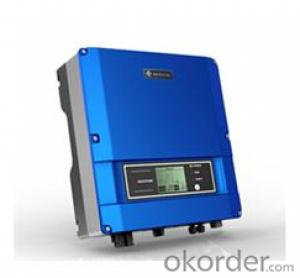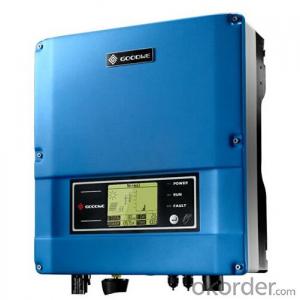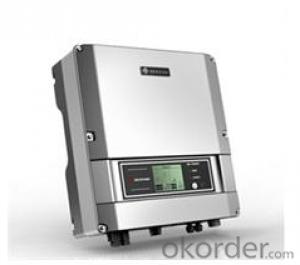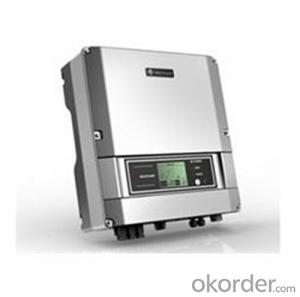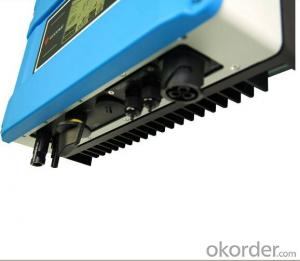Sharp Solar Inverter GS4200-DS On Grid Solar Inverter
- Loading Port:
- Shanghai
- Payment Terms:
- TT OR LC
- Min Order Qty:
- 10 unit
- Supply Capability:
- 100 unit/month
OKorder Service Pledge
OKorder Financial Service
You Might Also Like
GW4200-DS
GW4200-DS photovoltaic inverter is suitable for home rooftop photovoltaic system, designed under modern industrial concept. There are three colors for option with fashionable appearance. This model uses advanced digital control technology and communication method as well as super MPP tracking and security technology. It has a wide range of input and output voltage. To ensure its stability and long service life, our inverter is manufactured with optimum quality components. It holds a safe lead among the same level of products.
| DC Input Data | Max.PV-generator power[W] | 4600 |
| Max.DC power each MPPT[W] | 2500 | |
| Max.DC voltage[V] | 580 | |
| MPPT voltage range[V] | 125~550 | |
| Turn on DC voltage[V] | 125 | |
Max.DC work current[A] | 2*15 | |
| Number of inputs/MPP trackers | 4/2(can parrallel) | |
| DC connector | MC IV connector | |
| Self-energy consumption[W] | <5< td=""> | |
| AC Output Data | Nominal AC power[W] | 4200 |
| Max.AC power[W] | 4400 | |
| Max.output current[A] | 21 | |
| Nominal output voltage range | According to VDE-AR-N 4105, RD1663, ENEL, G59,SAA | |
| AC grid frequency | According to VDE-AR-N 4105, RD1663, ENEL, G59,SAA | |
| THDi | 〈2% | |
| Power factor | 0.95 leading...0.95 lagging | |
| AC connection | Single phase | |
| Efficiency | Max.efficiency | 97.8% |
| European efficiency | 97.4% | |
| MPPT adaptation efficiency | >99.5% | |
| Safty Equipment | Leakage current monitoring unit | Integrated |
| DC switch disconnector | Optional | |
| Islanding protection | AFD | |
| Grid monitoring | According to VDE-AR-N 4105,AS4777.1/2/3, RD1663, ENEL,G59-2 | |
| Normative Reference | EMC compliance | EN 61000-6-1,EN 61000-6-2, EN 61000-6-3,EN 61000-6-4 |
| Safety compliance | According to IEC 62109-1,AS3100 | |
| General Data | Dimensions(W*H*D) [mm] | 390*417*165 |
| Net weight [kg] | 20 | |
| Housing | For outdoor and indoor | |
| Mounting information | Wall mounting | |
| Operating temperature range | -20~60℃(up 45℃ derating) | |
| Relative humidity | 0 ~ 95% | |
| Site altitude[m] | 2000 | |
| IP proection class | IP65 | |
| Topology | Transformerless | |
| Cooling | Nature Convection | |
| Noise level[dB] | 〈25 | |
| Display | 4" LCD | |
| Communication | USB2.0;RS485(Wireless/Bluetooth optional) | |
| Standard warranty[years] | 5/10(optional) |
- Q: What is the role of a maximum power point tracker in a solar inverter?
- The role of a maximum power point tracker (MPPT) in a solar inverter is to ensure that the solar panels are operating at their maximum power output. The MPPT continuously monitors the voltage and current of the solar panels and adjusts the operating conditions to find and maintain the maximum power point. This optimization helps to maximize the efficiency and overall energy generation of the solar system.
- Q: Can a solar inverter be used with different types of monitoring systems?
- Yes, a solar inverter can be used with different types of monitoring systems. Most modern solar inverters are designed to be compatible with various monitoring systems, allowing users to choose the system that best suits their needs and preferences. This flexibility enables the integration of different monitoring technologies, such as Wi-Fi, Ethernet, or cellular connectivity, making it easier to monitor and manage solar energy production.
- Q: How does a solar inverter handle voltage drop in long cable runs?
- A solar inverter compensates for voltage drop in long cable runs by boosting the voltage to ensure efficient power transmission.
- Q: Can a solar inverter be used with a solar-powered agricultural irrigation system?
- Yes, a solar inverter can be used with a solar-powered agricultural irrigation system. The solar inverter is responsible for converting the direct current (DC) produced by the solar panels into alternating current (AC) that can be used to power the irrigation system. This allows for efficient utilization of solar energy to operate the irrigation system, reducing reliance on traditional power sources and promoting sustainable agriculture practices.
- Q: What is the maximum AC output power of a solar inverter?
- The maximum AC output power of a solar inverter is determined by its capacity and specifications, but it typically ranges from a few hundred watts to several kilowatts.
- Q: How does a solar inverter handle reactive power?
- A solar inverter handles reactive power by implementing power factor correction technology. It actively measures the power factor of the system and adjusts the reactive power to ensure optimal performance and efficient energy conversion. This helps in maintaining a balanced and stable grid connection while minimizing power losses.
- Q: Are there any disadvantages of using a solar inverter?
- Yes, there are some disadvantages of using a solar inverter. One disadvantage is the initial cost of purchasing and installing the inverter, which can be quite expensive. Additionally, solar inverters are dependent on sunlight, so if there is a lack of sunlight or during nighttime, the inverter may not be able to generate electricity. Another potential disadvantage is the need for regular maintenance and potential repairs, which can add to the overall cost of using a solar inverter. Finally, the efficiency of solar inverters can be affected by factors such as shading, dust, or dirt on the solar panels, which can decrease their overall performance.
- Q: Can a solar inverter be used with a solar-powered vehicle?
- Yes, a solar inverter can be used with a solar-powered vehicle. The solar inverter is responsible for converting the DC power generated by the solar panels into AC power that can be used to power various devices and components in the vehicle, such as the motor, lights, and electronics.
- Q: What is the role of a power control feature in a solar inverter?
- The role of a power control feature in a solar inverter is to regulate and optimize the flow of electricity from the solar panels to the electrical grid or to the connected devices. It ensures that the power generated by the solar panels is converted and delivered efficiently, while also monitoring the voltage and frequency levels to maintain a stable and reliable power supply. Additionally, the power control feature enables the inverter to synchronize with the grid and comply with local regulations and requirements.
- Q: What is a solar inverter?
- A solar inverter is an essential component of a solar power system that converts the direct current (DC) generated by solar panels into alternating current (AC) electricity suitable for use in households and businesses. It ensures optimal performance and connectivity between the solar panels and the electrical grid, allowing for efficient utilization of solar energy.
Send your message to us
Sharp Solar Inverter GS4200-DS On Grid Solar Inverter
- Loading Port:
- Shanghai
- Payment Terms:
- TT OR LC
- Min Order Qty:
- 10 unit
- Supply Capability:
- 100 unit/month
OKorder Service Pledge
OKorder Financial Service
Similar products
Hot products
Hot Searches
Related keywords
